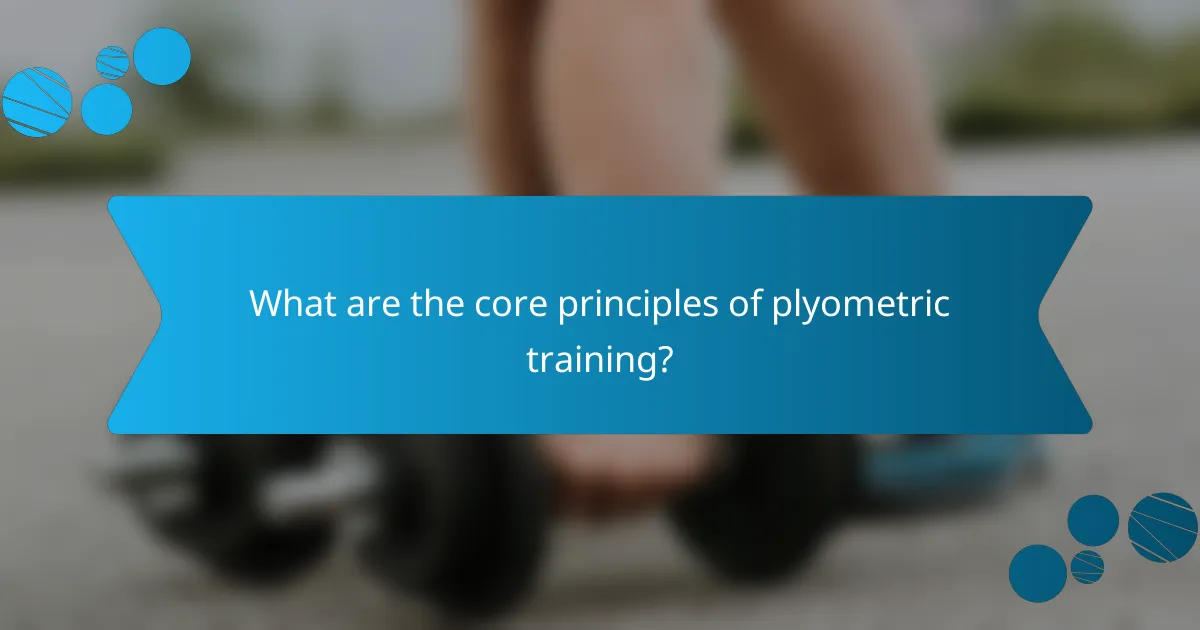Plyometric training enhances athletic performance by improving power, speed, and agility. This article explores effective methods like jump squats and box jumps, highlights the advantages of increased muscle strength and coordination, and discusses essential injury prevention strategies. Proper technique and gradual progression are crucial for maximizing benefits while minimizing risks. Tailoring exercises for different populations ensures safety and effectiveness in training.

What are the core principles of plyometric training?
The core principles of plyometric training include explosive movements, rapid muscle stretching and contracting, and specific training adaptations. These principles enhance power, speed, and overall athletic performance. Plyometric exercises, such as jump squats and box jumps, utilize the stretch-shortening cycle to improve muscle efficiency. Proper technique and progressive overload are essential to maximize benefits and minimize injury risk.
How does plyometric training enhance athletic performance?
Plyometric training significantly enhances athletic performance by improving power, speed, and agility. This training method involves explosive movements that increase muscle strength and reaction time.
Key advantages include increased muscle elasticity, which leads to more efficient energy use during athletic activities. Plyometric exercises, such as box jumps and depth jumps, promote neuromuscular adaptations, enhancing coordination and balance.
Additionally, plyometric training can reduce the risk of injuries by strengthening connective tissues and improving joint stability. Athletes who incorporate these exercises often experience improved overall performance metrics, such as faster sprint times and higher vertical jumps.
Which muscle groups benefit most from plyometric exercises?
Plyometric exercises primarily benefit the lower body muscle groups, including the quadriceps, hamstrings, calves, and glutes. These explosive movements enhance power and strength, improving athletic performance. Upper body muscles, such as the chest, shoulders, and triceps, also gain from plyometric training through exercises like clap push-ups. Overall, plyometric training effectively targets multiple muscle groups, promoting overall strength and agility.

What methods are commonly used in plyometric training?
Plyometric training commonly utilizes methods like jump squats, box jumps, and depth jumps. These techniques enhance explosive power and agility by engaging fast-twitch muscle fibers.
1. Jump Squats: Involves squatting and jumping explosively, targeting lower body strength and power.
2. Box Jumps: Athletes jump onto a raised platform, improving vertical leap and coordination.
3. Depth Jumps: A drop from a height followed by an immediate jump, enhancing reactive strength.
4. Lateral Bounds: Side-to-side jumps that develop lateral agility and balance.
5. Medicine Ball Throws: Throws that combine upper body strength with explosive movement.
6. Plyometric Push-Ups: Push-ups with an explosive push off the ground, enhancing upper body power.
These methods offer various advantages, including increased muscle power, improved athletic performance, and enhanced coordination while minimizing the risk of injury when performed correctly.
How do different plyometric exercises compare in effectiveness?
Plyometric exercises vary in effectiveness based on their design and target muscle groups. Box jumps, for example, enhance vertical power, while depth jumps improve reactive strength.
| Exercise Type | Primary Focus | Effectiveness Metric |
|——————-|—————————-|————————–|
| Box Jumps | Vertical power | Height achieved (inches) |
| Depth Jumps | Reactive strength | Time to rebound (seconds) |
| Broad Jumps | Horizontal power | Distance covered (feet) |
| Plyometric Push-Ups| Upper body explosiveness | Reps completed (count) |
| Medicine Ball Throws| Core power | Distance thrown (feet) |
| Single-leg Hops | Balance and stability | Distance (feet) |
Incorporating various plyometric exercises can optimize athletic performance and reduce injury risk.
What is the role of equipment in plyometric training?
Equipment plays a crucial role in plyometric training by enhancing performance and safety. Proper tools, such as boxes, hurdles, and resistance bands, increase the effectiveness of explosive movements. They allow for varied intensity and progression, accommodating different skill levels. Additionally, equipment can aid in injury prevention by promoting correct form and reducing impact on joints.
Which plyometric drills are recommended for beginners?
Beginner-friendly plyometric drills include box jumps, squat jumps, and lateral bounds. These exercises enhance power, agility, and coordination while minimizing injury risk. Start with low heights and focus on form. Gradually increase intensity as strength improves.

What advantages does plyometric training offer?
Plyometric training offers numerous advantages, including improved power, speed, and agility. It enhances muscle strength and coordination, which can lead to better athletic performance. Additionally, plyometric exercises can boost cardiovascular fitness and promote weight loss. They also improve joint stability and reduce the risk of injury through better proprioception and muscular control.
How does plyometric training improve power and explosiveness?
Plyometric training enhances power and explosiveness by improving muscle strength and speed through rapid, high-intensity movements. This training method increases the rate of force development, essential for athletic performance. Key benefits include enhanced muscle elasticity and improved neuromuscular coordination. As a result, athletes experience better jump height and sprint speed, contributing to overall performance improvements.
What impact does plyometric training have on cardiovascular fitness?
Plyometric training significantly enhances cardiovascular fitness by improving heart rate and oxygen uptake. This high-intensity training method engages multiple muscle groups, leading to increased aerobic capacity and endurance. Studies show that incorporating plyometrics can elevate heart rate to 85-90% of maximum during workouts, promoting cardiovascular health. Additionally, it contributes to efficient energy utilization, making the body more adept at sustaining prolonged physical activity.
Why is plyometric training beneficial for injury prevention?
Plyometric training is beneficial for injury prevention as it enhances muscle elasticity and joint stability. This form of training improves neuromuscular control, which reduces the risk of injuries during athletic activities. Plyometric exercises promote stronger tendons and ligaments, making them more resilient to stress. Additionally, they improve overall athletic performance by increasing power and agility. A study found that athletes incorporating plyometric training experienced a 30% reduction in injury rates compared to those who did not.

What are the common risks associated with plyometric training?
Plyometric training carries several common risks, including joint injuries, muscle strains, and tendon injuries. These risks arise from the high-impact nature of the exercises, which can lead to overuse and improper technique.
Proper warm-up and cooldown routines are essential to mitigate these risks. Gradual progression in intensity and volume is also crucial for injury prevention. Additionally, ensuring adequate recovery time helps reduce the likelihood of injuries associated with plyometric training.
How can participants assess their readiness for plyometric training?
Participants can assess their readiness for plyometric training by evaluating their strength, balance, and overall fitness level. Key indicators include the ability to perform basic strength exercises, such as squats and lunges, without discomfort. A proper warm-up and mobility assessment are essential for identifying any limitations. Additionally, monitoring fatigue levels during workouts can help gauge readiness for high-impact activities. Engaging in lower-intensity plyometric drills can serve as a preliminary test to determine comfort and capability before progressing to more advanced training.
What are the signs of overtraining in plyometric workouts?
Signs of overtraining in plyometric workouts include persistent fatigue, decreased performance, and increased injury risk. Other indicators are mood swings, insomnia, and elevated resting heart rate. Monitoring these signs is crucial for effective training and injury prevention. Regularly assessing recovery and performance can help athletes adjust their training intensity.

What strategies can be implemented for injury prevention in plyometric training?
Implementing injury prevention strategies in plyometric training includes proper warm-ups, technique refinement, and appropriate progression. Start with dynamic stretches to enhance flexibility and blood flow. Focus on mastering form to reduce injury risk. Gradually increase intensity and volume to allow adaptation. Incorporate strength training to support joints and muscles. Lastly, ensure adequate recovery between sessions to prevent overuse injuries.
How important is proper warm-up and cool-down in plyometric training?
Proper warm-up and cool-down are crucial in plyometric training to enhance performance and prevent injuries. A warm-up increases blood flow and prepares muscles for explosive movements, while a cool-down aids recovery and reduces muscle soreness. Studies indicate that a structured warm-up can improve power output by 10-20%. Furthermore, incorporating dynamic stretches in the warm-up and static stretches in the cool-down can significantly lower injury risks. Prioritizing these practices fosters a safer and more effective training environment.
What role does technique play in minimizing injury risk?
Technique plays a crucial role in minimizing injury risk during plyometric training by ensuring proper form and movement patterns. Correct technique reduces stress on joints and muscles, preventing overuse injuries. Key aspects include landing mechanics, body alignment, and controlled movements. For example, maintaining a soft landing with knees aligned over toes decreases impact forces. Additionally, gradual progression in intensity and volume allows the body to adapt, further lowering injury risk. Prioritizing technique fosters a safer training environment and enhances performance outcomes.
Which recovery methods are effective after plyometric sessions?
Active recovery methods are effective after plyometric sessions. Techniques such as light jogging, stretching, and foam rolling promote blood flow, reduce muscle soreness, and enhance flexibility. Incorporating hydration and nutrition aids in muscle repair and replenishment. Prioritizing sleep also supports overall recovery and performance.

How can plyometric training be adapted for different populations?
Plyometric training can be tailored for different populations by modifying exercise intensity, volume, and complexity. For older adults, low-impact variations reduce joint stress while maintaining benefits. Athletes may focus on explosive movements to enhance performance, while beginners should start with basic drills to build foundational strength. Children benefit from playful, game-like activities that foster coordination and enjoyment. Individuals with injuries require carefully monitored progressions to ensure safety and effectiveness.
What considerations should be made for older adults engaging in plyometric training?
Older adults engaging in plyometric training should prioritize safety, proper technique, and individualized progression. They must consider joint health, balance, and strength levels to minimize injury risk.
1. Assess joint health: Evaluate conditions like arthritis that may affect performance.
2. Start with low-impact variations: Use modified exercises to reduce stress on joints.
3. Focus on balance training: Incorporate stability work to enhance coordination.
4. Gradually increase intensity: Progress slowly to avoid overexertion and injuries.
5. Consult professionals: Seek guidance from trainers experienced in senior fitness.
How can youth athletes safely incorporate plyometric exercises?
Youth athletes can safely incorporate plyometric exercises by following proper techniques and guidelines. Start with a thorough warm-up to prepare muscles and joints. Gradually introduce plyometric movements, focusing on form over intensity. Use appropriate surfaces, such as grass or rubber, to minimize impact. Incorporate rest periods to allow for recovery and prevent fatigue-related injuries. Monitor progress and adjust the training volume based on individual capabilities. Prioritize exercises that suit their developmental stage, ensuring they are age-appropriate and aligned with their overall training goals.

What best practices should be followed for effective plyometric training?
To achieve effective plyometric training, focus on structured progression, proper technique, and recovery. Start with basic movements before advancing to complex exercises. Incorporate variety in drills to enhance power and agility. Prioritize warm-ups and cooldowns to prevent injuries.
How can athletes track progress in plyometric training?
Athletes can track progress in plyometric training by monitoring specific performance metrics. Key methods include measuring jump height, recording the number of repetitions, and timing sprint intervals. Regular assessments help identify improvements in explosive strength and overall athletic performance. Using video analysis can also provide insights into technique and form, allowing for targeted adjustments.
What common mistakes should be avoided in plyometric workouts?
Common mistakes to avoid in plyometric workouts include inadequate warm-up, improper landing techniques, neglecting recovery, and overtraining. These errors can lead to injuries and diminish workout effectiveness.
Inadequate warm-up can result in muscle strains. Proper landing techniques help absorb impact and prevent joint injuries. Neglecting recovery affects performance and increases injury risk. Overtraining can lead to fatigue and burnout, hindering progress.
Which expert tips can enhance plyometric training outcomes?
Incorporating expert tips can significantly enhance plyometric training outcomes. Focus on proper technique, progressive overload, and adequate recovery to maximize effectiveness and minimize injury risk.
1. Prioritize form to ensure safety and effectiveness.
2. Gradually increase intensity and volume to promote strength gains.
3. Incorporate varied exercises to target different muscle groups.
4. Allow sufficient rest between sessions for recovery.
5. Monitor progress with metrics like jump height and landing stability.